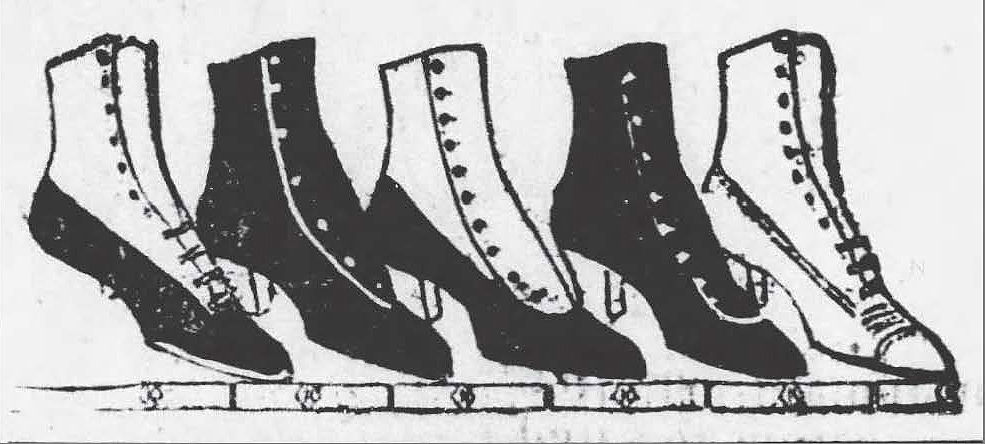The fashion and etiquette rules of 1898 may seem archaic, but they make for entertaining reading.
Now, make sure your shoes wear evenly on the soles, but don't lace them sloppily.
From the Arizona Daily Star, Friday, June 10, 1898:
LATE FASHION NOTES
The varieties of decoration in burnt-leather bicycle accessories are chic and charming.
Ready-made ruffling of mousselines and Persian organdies for skirts are a feature of the lace counters.
Double warp cashmere closely resembling drap-d'ete in delicate tints and beauty of finish is one of the loveliest of light wool summer fabrics.
A very dark blue gown seen at this season is garnitured with empire green. If it is a thin one the stock and girdle are of this shade of taffeta ribbon; if of silk or wool, then taffeta silk is used.
Strips of white embroidery set horizontally on the blouse bodice and curved pieces of the same on bolero jacket pieces give a lovely effect to lavender and pale green lawns, dimities and chambrays.
According to Websters, a mousseline is a fine, semiopaque fabric and Drap d'été is a thin woolen or blended fabric that has a twill weave and is used especially for summer clothing. Garniture is decoration.
From the same day in the Star:
POINTS OF ETIQUETTE
An engagement ring that is not costly has, set in its gold band, a small turquoise.
After laying aside crape a gown of black camel's hair or vicuna cloth trimmed with wool braid on skirt and bodice may be worn.
A costly ring should not be worn by a girl in the workaday world to the office where she is employed, as it is in extremely bad taste.
Politeness demands that a lady permit a gentleman near her to restore to her a fan, glove, handkerchief or any small belonging which she may have dropped.
Fashionable gloves are of a pale tan with delicate stitching of faint blue or scarlet on the kacks. The stitching is not conspicuous, and the four buttons proclaim that they are for street wear.
The good musician who can give pleasure to people, and declines to do so without much urging, is properly treated when her genius is ignored, and some more polite, but less able, girl is invited to be the musician of the evening. —Ladies' Home Journal.
Crape may be mourning attire. We could find no definition for the kacks on gloves.
From the Star, Saturday June 11, 1898:
TOLD BY SHOES OR HAIR.
One can always tell if a woman is of gentle birth by the texture of the hair. The finer it is, the higher born is she. Her mode of life is easily seen from her hair, for the finest hair is never really glossy without careful training. Coarse hair will never become very glossy.
One can safely choose a friend by observing his shoes. If after a couple of months' wear the soles and heels are worn evenly you may know the owner is a resolute business man or a genial, pleasant woman with a clear head. If the sole is worn on the outside the wearer is capricious, self-willed, uncertain and adventurous.
The lighter in color the hair is, the more sensitive and touchy is the owner, except in rare cases, where perfect health is enjoyed. Any shade of brown hair is good, for brown hair usually covers a wealth of common sense, reason and judgment. Red-haired women are quick and clever, too impulsive, perhaps, but sincere and worthy of trust.
Curly hair indicates a poetic, graceful nature. The closer the ends of the hair lie together the greater the intellectual power of the owner. Women with straight and soft hair have greater force of character than those whose hair is curly. Black, lusterless hair indicates jealousy and treachery. Rough and uneven hair shows an unbalanced character, and all cranks have hair which is broken and split.
The way people walk is an unerring guide to character. A weak and hesitating person wears his shoes on the inner side, while a cheerful, light-hearted person walks with an elastic step and wears the soles of his shoes evenly. The shoe kicked out at the heels denotes depression. Never have anything to say to a lover who laces his boots very, very tight, for he will be stingy and horrid toward his wife. Easily-laced shoes mean that he will be kind and attentive, but careless lacing shoes a man to be a villain; so give him a wide berth.
What should one think of a brown-haired person with tightly laced shoes? Or a red head with careless lacing? Perhaps we should just give these ideas a wide berth.





